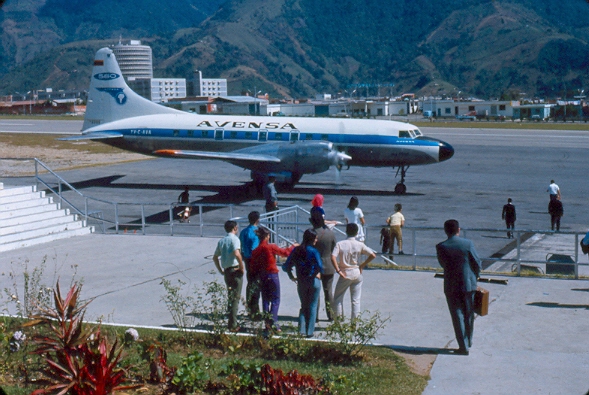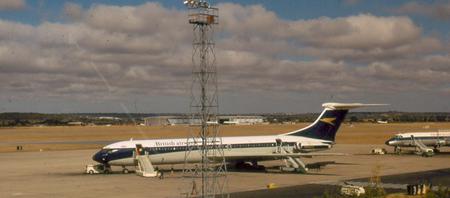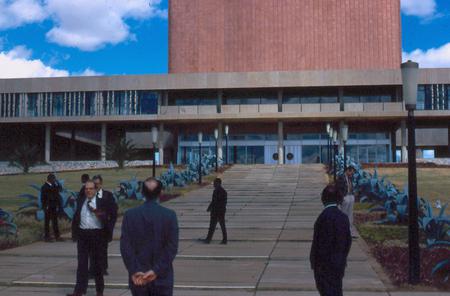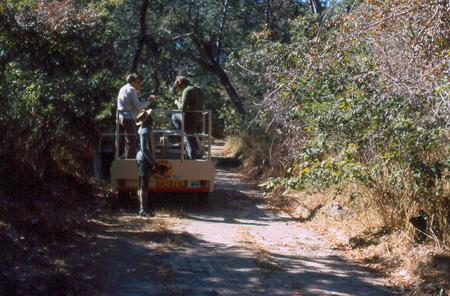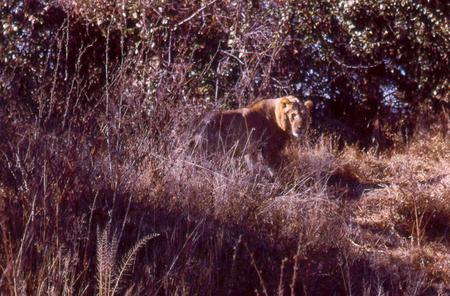Memoirs of a Boffin
Chapter 12: Science in the Third World
It was during the early 1970s that I became involved with the science policies of developing countries as well as those of countries represented by OECD and NATO. Through the Prime Minister’s Office, in 1970, I had been asked by the Science Policy Division of UNESCO if I would go to Venezuela to advise their Science Council on a major statement of national science policy which they were then preparing. This started me on a series of visits, not only to Venezuela but also to Guyana, as a UNESCO science policy adviser.
On my first journey to Caracas, in February, 1970, I stopped over in Barbados for three days to renew the acquaintance I had made with that lovely island during the HARP trials in 1966. I picked up the second leg of the BOAC London-Barbados-Caracas flight to take me to Venezuela. It was a BOAC “Speedbird” VC 10 – one of the most beautiful (and one of the first) big passenger jets. I shall never forget the landing at La Guaira airport, where the aircraft flew straight in towards the cliffs, then banked at the last moment into the final glide path, showing the great expanse of its graceful white wing. No wonder the Soviets copied it as the Ilyushin II-62 (or the Veeceetenski as I call it).
I was met at the airport by Dr. Marcel Roche, President of the Science Council of Venezuela, who was my delightful official host for the visit. He drove me to the Tampa Hotel where he handed me an envelope saying, “Here’s a draft of the proposed document; maybe you’d like to study it for a day or two. I’m leaving now for the long weekend (it was Friday afternoon), so I’ll see you on Tuesday.”
I was mildly surprised at this, as nothing had been said in his letters about a long weekend. However I welcomed the chance to read the document and to have some time to get to know Caracas. Then came the next surprise; I opened the envelope and the 45-page report was in Spanish – a language I have never studied. I had raised the subject of language with de Hemptinne at UNESCO but he had dismissed it saying they (the Science Council) were all fluent in English (which turned out to be quite true, but didn’t help the immediate problem). So I sat down after dinner and started a painstaking translation of the document for my own benefit. By this time the stores were closed and I had no Spanish-English dictionary, so I had to do my best without one. Within an hour or so I began to get the hang of it. I found that 90% of the words became intelligible through a knowledge of French or Latin, both of which I knew pretty well from my eight years at Clitheroe Royal Grammar School. As the document was on R and D, I soon cottoned on that desarollo meant development and I guessed at a few other words by similar associations. As a result, when Marcel Roche returned on the Tuesday, I was able to present him with my comments as well as a creditable translation of the report.
Science and technology policy in Venezuela was in a very early stage of development. As so often happens in developing countries – even ones as far advanced as Venezuela, there was a core of scientists, many of whom had been educated abroad. They had created a National Research Council (IVIC), with laboratories in the hills near Caracas, where they conducted research of internationally recognized quality. The government had recognized the gap between this activity and the need for the application of science and technology to the economic needs of Venezuela and had created the Science Council (CONICIT) who were my hosts and newly responsible for developing a government science policy. I remember commenting on the difficulties these bodies had communicating with industries who employed very few if any scientists and technologists in research. It takes two to make a dialogue and it was difficult for CONICIT to find a community outside the government which had the people who could give enough thought to these matters to provide the basis for intelligent discussion.
I pointed out that you cannot change industry by means of a technological ‘push’ from the outside. First you need to create the circumstances which make the industries see the need to establish research work of their own. One of the problems was the emigration of graduate scientists and technologists. I estimated at the time there were only 200-500 people in the entire country engaged in scientific research and development at an effective level. I suggested that the government should make it more attractive for ex-patriate Venezuelans to return to do research in their own country. This could only be done if the Science Council were given enough influence in government to create the necessary infrastructure to receive them and to create a demand for them in the private sector. This could be done by initial government funding for small research laboratories in the key industries, closely linked to the National Research Council, IVIC, in the initial stages of development. IVIC should, under the proper conditions, attract ex-patriots itself and pass them on to industry at the appropriate time.
I had a couple of adventures during that visit to Venezuela. Dr. Roche arranged for me to visit the university city of Merida, which lies in a valley between 15,000 foot mountains in the Andes. I flew there in a VIASA Convair – apparently one of the few types of plane that could climb steeply enough to get out of Merida through the climbing pass that was the sole route in and out of the airport. I had noticed during the approach that we were already flying very low several miles from the airport and realized that we were descending over the foothills and the ground was falling away at about the glide angle, so we remained at a fairly constant height above ground until the last few seconds before landing.
I was taken on a tour of the University and was received most enthusiastically, especially by the research staff in the Physics Department – so much so that they made me postpone my flight and return for an hour or two the following morning. My new flight was mid-afternoon, which would allow me just enough time to get to the Hotel and change clothes before giving an address at 7.00 p.m. to INVESTI (the industrial research association of Venezuela), followed by a reception and dinner in honour of my visit.
The VIASA Convair was late coming in, so it was all bustle to unload the aircraft, then to board the passengers and baggage. We took off into the climbing pass. It seemed that there was barely room for the wingspan between the slopes on either side. We had been off about 15 seconds when there was an almighty bang and the aircraft checked and staggered. Then another loud noise, followed by the tense voice of the Captain saying, “Make sure your seat belts are secure for immediate landing.” There was clearly no room to turn in the pass and we had very little height, so I (and I am sure all the other passengers) tensed myself for the inevitable crash. The aircraft banked almost vertically against the mountainside to starboard, then pivoted on its wing, missing the other wall by what appeared to be inches. He held just enough height to enable us to get back on the runway within little more than two minutes from takeoff.
It turned out that the baggage compartment of the Convair has a door in the nose of the aircraft. A boy had stuffed a last-minute piece of luggage in it and neglected to secure the catch. The baggage door had blown open on takeoff and, shortly afterwards, the pressure had blown open another hatch, further aft (the second bang). The pilot banged the door shut, gave the machine a peremptory examination and was back in the air within 5 minutes, this time without incident. By this time I was very late. I was met at the airport in Caracas and rushed around the coastal range to the Auditorium where I was to give my address to INVESTI. The talk went fine, until near the very end, when events caught up with me and I lost my voice. I uttered the last couple of sentences in a whisper. Then I was introduced to my host for the evening. It turned out that the reception and dinner was to be at his country mansion in the mountains south of Caracas. Apparently he and his sons owned a significant part of Caracas, but I confess I no longer remember his name.
We drove for about an hour. It was cloudy at first, then we emerged above the clouds and arrived at this magnificent country place, which must have been at an altitude not much below 10,000’ (Caracas is at 6,000’). Of course this did nothing to help my laryngitis. By now I couldn’t utter a sound. I was greeted by his wife who turned out to be a most gracious and solicitous hostess. She shot off without fuss to find medication and effortlessly neutralized the embarrassment I had felt.
Our hosts had set up a huge buffet under the stars. A fire was burning in a gigantic barbecue pit and we had magnificent steaks as the main course of a delightful meal. There must have been nearly 100 people present, seated at tables for 8 or so. I was seated with the host and Dr. Roche, with the young wife of one of the host’s sons (who owned a radio station among other things) sitting on my other side. She was strikingly beautiful as well as being dressed in all her finery, with a fortune in jewels. Her husband, who was seated at a nearby table, was a big aggressive looking young man. Of course, in order to converse with her, because of my laryngitis, I had to speak only an inch or so from her ear. As we seemed to have lots to talk about I suddenly realized that this must present a pretty cozy picture to the husband. Out of the corner of my eye I saw him glaring at us. I was afraid for a while that my visit to Venezuela might come to a sticky end, so I eased off and talked to my colleague Marcel Roche for the rest of the meal.
After all this, I was very glad to stop off once more in Barbados to rest, write up my report to UNESCO and recover my voice, before returning home.
I was invited back to Venezuela in 1973 to continue the work on science policy. This time my wife, Nesta was invited to come too. We spent a glorious week in Barbados en route. We arrived on a Sunday in March and, while we were in the taxi from the airport to the hotel, we saw families dressed in their Sunday best going to church. The children were delightful, especially the little girls in their spotless frilly dresses. Nesta remarked to the taxi driver, “What a beautiful country!” He replied, “Yes it is; we don’t have most of the problems of the so-called developed countries.” Nor did they at that time. But the building of the big American chain hotels and the consequent increase in the number and origin of tourists has changed all that.
It was with regret that we left Barbados for Caracas, where we were met by Marcel Roche and escorted to a new high-rise hotel in the expensive Sabanna Grande district of Caracas. He left us to check in and the manager took us up to our ‘room’. When he unlocked the door we found ourselves in a palatial suite. As the UNESCO living allowance is a pittance and the fees nominal, we looked at the rate posted on the back of the door. It was several times our allowance. So we looked at each other and said, “What the hell – it doesn’t happen that often,” and decided to stay and hang the cost. Still, we felt terribly extravagant throughout the visit, until we asked for the bill at the end and the Manager said, “It has all been taken care of by your hosts.”
Indeed, everyone there was most gracious and helpful. Nesta was window-shopping alone one day in the Centro Commercial de Chacaito. That is a shopping centre of a type that is rare in Canada – a boutique plaza. The dresses started at $500 and the paintings at $5,000; the centre was full of teenagers in designer pant-suits and the car park full of Mercedes and Jaguars. She entered an antique shop and, when the elderly proprietor approached her she hastily said she was “just looking”. He asked her if she was visiting, where from, and if she was on holiday. She said, “I’m from Canada; it’s part holiday, but my husband is here on business.” He responded, “You must be Mrs. Whitehead.” Nesta was astounded. But it turned out that the proprietor, Maxime Silberg, was a Member of the Science Council of Venezuela and had been present at my speech and the dinner on my previous visit. He insisted that she bring me round to see him as soon as she could. The following day we both visited the shop. We were surprised at the number of rare archaeological specimens he had for sale. His personal enthusiasm was collecting old glass from the period before 1000 BC. As a memento of our visit, he presented us with a small earthenware jar containing a replica of the Dead Sea Scrolls.
It turned out that this delightful man was the Vice-President of INVESTI, the industrial research association of Venezuela. He was very concerned about the direction of Venezuelan science policy and he offered to do anything he could to help me. I told him some of the gaps in my knowledge of the history of the Science Council and he listened with interest. Imagine my surprise when the next day, which was Sunday, he came trotting round to the Hotel carrying a huge pile of files and documents. I was impressed that this elderly multi-millionaire would be so concerned and so modest as to take all this trouble. The gesture was typical of the kindness I met throughout the trip.
I think I helped Marcel Roche and CONICIT significantly with their efforts to develop and implement a National Science Policy while I was with them in Venezuela. Whether anything ever happened to the lengthy report I submitted to UNESCO is another question. That bureaucracy is practically impermeable.
It was in July of the following year, 1974, that I attended the Commonwealth Conference in Zambia. I flew there in a BOAC VC10 from London via Khartoum. We were in Khartoum for less than an hour, but it was long enough for me to make the resolve never to return. It was as hot as hell and as depressing as my most pessimistic image of it. Deserts, whether hot or cold, are not my cup of tea.
On arrival in Lusaka, I had a quite different reaction. Everything was lush and Lusaka was very English in appearance – green boulevards tidily bounded by curbstones; beautifully tended ‘roundabouts’ (traffic circles), with lawns and flower beds in the middle; lovely churches and spacious streets.
The organization of the meeting and the conference facilities were excellent and there was plenty of time left to explore the city. I had the most fun bargaining with the sellers of wood carvings, masks and malachite on the boulevard divider of the main street in Lusaka. I must have walked the length of it twenty times, keeping my eye on what I really wanted and hearing a lower offer each time I passed. There was a lot of good-humoured banter before the final deals were made. I think the entertainment value to both sides well exceeds the commercial aspects of the process.
The meeting was chaired by Arnold Smith, a distinguished Canadian who was the Commonwealth Secretary General for many years, to be succeeded shortly afterwards by ‘Sonny’ Ramphal from Guyana. When I heard in recent years that Ramphal had been knighted by the Queen, I remember reflecting that no-one had deserved a knighthood more than Arnold Smith. Presumably the only reason he did not have one is due to the convoluted snobbery of a Canadian government that misguidedly inhibits its citizens from accepting them. As if it could do any harm! Will Canada always live in a state of apprehension about its national independence and continue to deny its historical ties to Britain?
At the end of the Commonwealth Conference, there was a week’s program of visits to copper mines and other industrial locations. Unfortunately (or, perhaps fortunately in the event), I had to leave halfway through that week, in order to get back to some event or other in Canada. The New Zealand delegate had a similar problem. When our hosts discovered this they laid on a special 3-day safari for us in the Kafue National Game Reserve.
We were flown to an airstrip at the edge of the Reserve and shown to quite comfortable quarters in one of several huts in the only settlement on the Reserve. There was a small bar and dining room in the central building. I believe they told us at that time that, including the warden and his staff and the facilities in which we were staying, there were fewer than 100 people in the 22,000 square kilometres of the Kafue Reserve at any given time.
We were driven out into the heart of the game park in a Safari Wagon – a small flatback truck with a rail down the middle to accommodate three or four people standing either side (and holding on for dear life!). It was 8 am on the day after we arrived. We were three visitors, accompanied by the chief game warden and two of his guards. It was ironical that it was freezing cold at 40 mph in the wagon, until the sun came up and after it went down, which were the times we were travelling long distances. It was overpoweringly hot the rest of the day when we were moving at a more leisurely pace, or standing still.
I was very impressed by the discipline of the warden and his men. They never relaxed their vigilance for an instant when we were off the truck. They clearly took the risk of surprise attack very seriously. I discussed this with the warden and he confirmed it, saying that it was rhino, elephants and crocodiles that were the main danger, although lions and cats could be in certain circumstances. Even so they had men wounded on the job.
We saw lots of water buffalo and zebra and several varieties of antelope, mainly lechwe, puku and the larger kudu and hartebeest. We also saw hippopotamus several times in the river and an immense crocodile basking on the edge of a large pool. Although we often came across fresh elephant droppings, we failed to see elephants on any of the three days. We did see one buffalo. Returning one evening, we saw a genet – its long striped tail unmistakable in the headlights. As we were turning into the compound that same evening we saw a leopard by the gatepost, transfixed by the headlights for a moment until it shot off into the bush. Each morning there were signs of hyena having been scavenging outside our hut and of lions sleeping under the bushes.
One day we were driving slowly down the dirt track when, about 20 yards ahead, a family of lions began to cross the road – a male, female and two cubs. The male continued the crossing with the cubs and led them into the bush. The lioness turned and ran down the road towards us and jumped up on a termite mound beside us as if to leap into the truck. She stood there for a few seconds while I took her picture, then turned the other way and vanished.
I was awakened one morning by the chatter of monkeys. I looked out of the window and there were dozens of them playing games around and on a tree just outside our door. These sights were no doubt familiar to the locals, but they were fascinating to us and we found it difficult to drag ourselves away. The birds were especially spectacular. We saw lots of parrot-like species and long-legged water birds such as the crane. We also saw lots of secretary birds in their formal black and white uniforms.
I have always been grateful to our Zambian hosts for giving us this opportunity to see one of the (then) less-trodden homes of African wildlife.
In 1976 I was asked by the Science Policy Division of UNESCO to visit Guyana to advise the newly-formed National Science Research Council of Guyana on the development of a science policy for the country.
I travelled there in July, not missing the opportunity to spend a day or two in my favourite Barbados en route. Landing in Georgetown from Barbados, I was met by my host, Dr. Pat Munroe, the Secretary General of the Council and taken to the Tower Hotel downtown through streets of buildings constructed in greenhart, the indigenous hardwood which had even been used to build the magnificent Anglican cathedral, in 1888. St. George’s Cathedral was a unique structure, entirely built of Greenhart. Unhappily it was burned to the ground early in the year 2005.
Independence, in 1966, had been followed by the nationalization of the main industries and had left Guyana with a strange mixture of English customs (and official language) with communist overtones. The official form of address within government was “Comrade”. The isolation of the Guyanese currency from the main world currency meant that people were not too badly off when buying anything produced in Guyana but imports were prohibitively expensive. Food was not plentiful and was very limited in variety and generally of poor quality. There was very little meat – skinny chicken and local fish were the main dishes offered at the hotel and I had the impression they were luxuries to the locals. The legacy of the feuds between the Negro and Indian populations was still evident in the continuing tussle between the tenuous, largely Indian private sector and the largely Negro government.
The main, traditional exports were bauxite and sugar. Alcan had built the “bauxite town” of Mackenzie around the bauxite plant and Canada had financed the 100-km road from Georgetown to Mackenzie. The town had been renamed Linden following independence. It was at that time the only metalled road in the interior of the country. The only other road ran along the coast from Corentyne river border with Surinam, in the south to a point (Charity) not far north of Georgetown. It was in four sections, broken by the estuaries of the great rivers, the Essequibo, the Demerara, and the Berbice. They had to be crossed by ferry.
I saw all this for the first time in my first few days in Guyana and I was faced with the job of trying to determine the relevance of science and technology to this country which had such low resources in a material sense and, as I soon found out, such fine human resources.
In trying to describe this, I see that we wrote at the time, in the preamble to the Science Policy Plan, the following words:
“A prime purpose of a science policy.....is to ensure that the opportunities afforded by science and technology to increase the speed and effectiveness of the development process are not lost by the absence of the necessary information and the scientific capability to develop, assimilate, adapt and use it. In other words, the recognition of the importance of science and technology in government policy can lead to a substantial increase in tangible results per dollar spent. Therefore, a science policy is a policy which deals with all the scientific and technical activities in the country and the relationship between them, wherever they are carried out. It does not imply centralization of authority nor of the conduct of science itself, which is ancillary to many operational units. It does imply a measure of agreement on the best use of the limited human and material resources in the country for the conduct of science and technology. In this sense, a science policy not only deals with science in government policy – the science components of the government plan – but also implies the development of a policy for the scientific community itself. The two are often confused.”
I expressed my views on science policy much more fully in a public lecture on “Science, Society and the Future” I gave in the Umana Yana on August 11th. 1976. It was a memorable evening for me. The Umana Yana is a very large auditorium or public meeting place built like a native hut with a huge conical thatched roof.
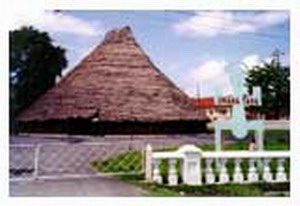
The Umana Yana
Literally hundreds of people assembled to hear the talk, which was carried, live, on Guyana Radio. On re-reading it seems to me just as valid today as it was then and to contain enough of my personal philosophy to include it as an annex to this book, even though the latter part of it is addressed specifically to the problems of Guyana. It is interesting in the light of later events that I commented even then on the uncertainties of climatic change albeit without specific mention of the greenhouse effect.
After the talk was over, refreshments including hot snacks were served to everybody. I was overwhelmed by the interest shown in what I had said. Everybody seemed to want to meet me and ask questions and it was very late before I was able to sneak away, exhausted from a party that showed every sign of continuing into the night.
The following morning I called in at the bank to cash a cheque. The teller said, “You gave that talk on radio last night didn’t you?” When I confessed I had she went on to discuss the substance of it quite seriously – enough to show that she had really listened to it. That was typical of the serious way in which a large part of the population of Guyana followed public affairs. There is something to be said for the absence of distractions like commercial television. All the work on the Plan and much of the speech-writing was done in far from ideal conditions in the headquarters of the Science Council – an old run-down building in not the best of locations. That was perhaps a measure of the importance the Government had previously given to science.
I never drove a car in Guyana. The dangers of hitting animals or people on the highway were deemed to be so great and the consequences of doing so likely to be so embarrassing that I was strongly recommended not to drive myself. I was provided with a station wagon driven by a cheery, confident youth who seemed to be delighted to do the job. One of the longest drives was on the mandatory visit to the Bauxite plant in Linden, on by far the best highway in Guyana. It was a beautiful day and we cruised along the empty highway at something near the maximum speed of the station wagon. However neither I nor, as it turned out, the driver knew that the highway did not enter Linden but came to an abrupt end in the countryside, a few miles short of the town. The turn to the dirt road to Linden was not obvious and we shot past it at full speed. The first thing I noticed was the clump of trees straight ahead that we were approaching at top speed and the end of the highway a few yards short of them.
We shot off the end of the highway like a bullet. I could see no hope of stopping short of the trees; it was obvious that we were going to hit them at high speed. But, miraculously, the wagon pulled up ten times more rapidly than any brakes could manage and stopped a foot or so short of the trees – half buried in sand! Thanks to the foresight, amounting to genius, of some engineer (presumably Canadian, because the road was Canadian built) a deep sandpit had been dug at the end of the road and we were buried in it up to the car windows. The stop had been very abrupt indeed, but just gradual enough to obviate serious injury.
The prospects of getting out of the car didn’t look too good and the prospects of getting the car out of the sand much worse. However, someone had spotted a National Service work gang a mile or so back, so our driver managed to crawl out through the window and go in search of them. He returned with about a dozen hefty looking youths who proceeded, without fuss to pick up the station wagon bodily and carry it out of the sand on to the highway. We continued the journey to Linden and toured the facilities there with hardly any delay of schedule.
Someone told me after I returned to Canada that our driver was new to the job and didn’t even have a license and was later convicted of dangerous driving after a fatal accident. I’m glad I didn’t know about his lack of experience at the time.
I returned to Guyana about a year later to consolidate the work I had done on the first visit. I was again immensely impressed by the friendliness and hospitality of the Guyanese people and by the serious interest the majority of them had in public affairs. At the time Guyana Radio modelled, no doubt, on the pre-war BBC, broadcast mainly public affairs, community and music programmes. There was little TV. Consequently people listened to talks and followed the activities of government and various public bodies far more closely than, for instance the majority of Britons or Canadians do today.
It was on this second visit that my host, Pat Munroe, took me to Sunday morning service at the Anglican Parish Church in the village that was his birthplace. I no longer remember its name but it was somewhere on the coast road south from Georgetown and past the mouth of the Mahaica river. He told me his father had been the Rector there for thirty-five years and he showed me his parents’ grave, just by the roadside. I was very touched by my reception in this all-Negro community and made to feel very much at home. The familiar, traditional Anglican service helped and I could not help reflecting as I stood there that it was exactly the same as it had been in Whalley or Great Harwood Parish churches where I went with my family, as a boy. It leads me to reflect that, today, the service at our local parish church has lost all its beauty, dignity and mystery, thanks mainly to the introduction of that ill-conceived atrocity, the Book of Alternative Services. In Guyana the service was strictly traditional and all the families were dressed in their Sunday best. The tiny children, in the front row, the girls all in frilly white, were models of good behaviour throughout the service; one of the happy legacies of British colonialism.
The Guyanese people have so much potential. It is a pity that political and racial strife have made so many of them leave the Country and have inhibited progress for those who have remained.

